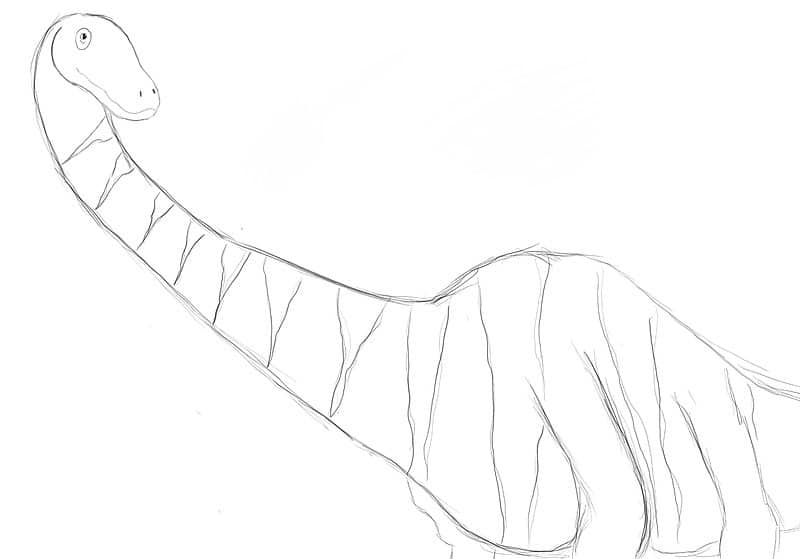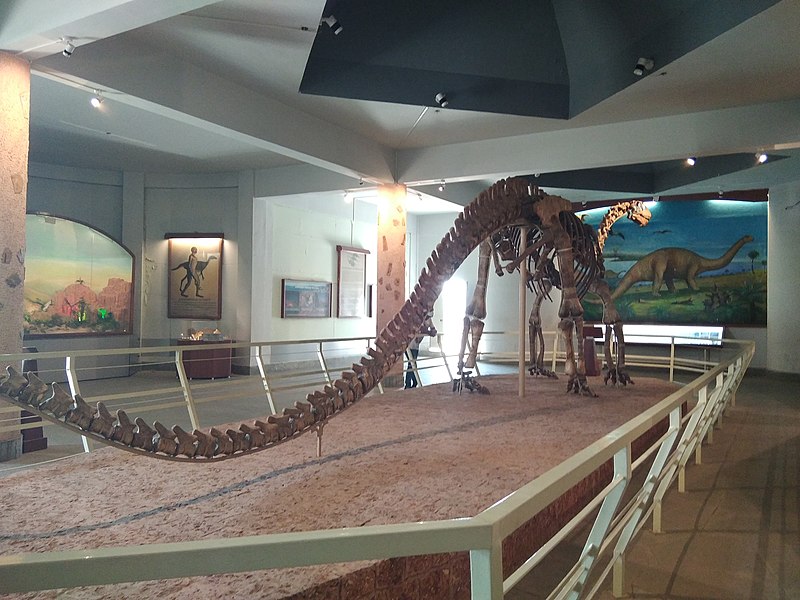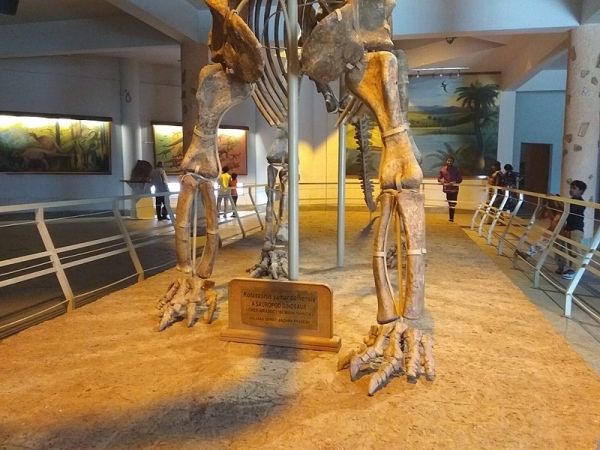Let’s embark on a jurassic journey, one that takes us back to a time when colossal creatures roamed the Earth. Our focus today is on a rather remarkable dinosaur, Kotasaurus. Discovered in the Kota Formation of India, this herbivorous sauropod offers a fascinating glimpse into the Early Jurassic Period.
Kotasaurus Key Facts
| Keyword | Fact |
|---|---|
| Pronunciation | koht-a-sore-us |
| Meaning of name | Kota Formation Lizard |
| Group | Eusauropoda |
| Type Species | Kotasaurus yamanpalliensis |
| Diet | Herbivore |
| When it Lived | 199.3 to 182.7 MYA |
| Period | Middle Jurassic (?) |
| Epoch | Uncertain |
| Length | 29.5 feet |
| Height | 9.8 feet |
| Weight | 2.5 tons |
| Mobility | Quadruped |
| First Discovery | 1970 |
| Location of first find | Kota Formation, Telangana, India |
| First Described by | 1988 by P. Yadagari |
| Holotype | 21/SR/PAL |
Kotasaurus Origins, Taxonomy and Timeline
Kotasaurus yamanpalliensis, a name that echoes through the corridors of time, is the only known species of its genus. Discovered in the lower member of the Kota Formation of Telangana, India, this sauropod shared its habitat with the related Barapasaurus, painting a picture of a diverse ecosystem. Remarkably, remains have been uncovered, offering a substantial glimpse into its existence. However, the puzzle remains incomplete as the skull, barring two teeth, eludes discovery.

This sauropod, a large, quadrupedal herbivore with a long neck and tail, is known from an area of 2,400 square meters near the village of Yamanpalli in Telangana. The proximity to the Barapasaurus type locality, about forty kilometers north, hints at a shared landscape.
Kotasaurus stands at a crucial junction in sauropod evolution. It’s one of the earliest-diverging sauropods known, showcasing a general body plan typical of sauropods but retaining several basal (plesiomorphic) features reminiscent of Prosauropods. Unlike the primitively bipedal prosauropods, Kotasaurus was an obligate quadruped.
In regards of the timeline, there’s a debate on the datation of the Kota Formation. It is considered to be either Early Jurassic or Middle Jurassic to Early Cretaceous.
Listen to Pronunciation
Discovery & Fossil Evidence
The discovery of Kotasaurus in the late 1970’s marked a significant addition to the world of paleontology. P. Yadagari’s efforts in the Kota Formation led to the unveiling of a dinosaur that would provide invaluable insights into the early stages of sauropod evolution. The discovery site, near Yamanpalli, became a treasure trove, yielding the remains of at least 12 individuals and a staggering 840 skeletal parts. However, the absence of a complete skull, save for two teeth, adds an element of mystery to Kotasaurus.
 Mounted skeleton of Kotasaurus; based on the holotype
Mounted skeleton of Kotasaurus; based on the holotype Legs of Kotasaurus
Legs of Kotasaurus
The fossils, confined to a relatively small area, paint a picture of a sauropod that once thrived in what is now Telangana, India. The proximity of these finds to the Barapasaurus type locality suggests a shared habitat, offering a glimpse into the diversity of life during that era. The degree of preservation and the types of fossils found provide a window into the past, allowing scientists to piece together the puzzle of Kotasaurus’s existence, despite the missing pieces.
Kotasaurus Size and Description
Kotasaurus, a distinguished member of the sauropod family, was an obligate quadruped. This means it moved exclusively on all four limbs, a characteristic that set it apart from the primitively bipedal Prosauropods. Its physical form was a harmonious blend of strength and size, with a long neck and tail that are hallmarks of sauropod anatomy. Despite the absence of a complete skull, the available skeletal parts paint a picture of a robust and well-adapted herbivore.
Size and Weight of Type Species
Kotasaurus, with an estimated body length of 30.0 feet and a weight of 2.5 tons, already mirrored the size of later sauropods. This impressive stature highlights its significance in the evolutionary timeline of sauropods. Its size not only reflects its adaptability to the lush, plant-rich environment it inhabited but also positions it as a substantial figure in the Early Jurassic landscape. The fact that Kotasaurus achieved such dimensions, comparable to its later relatives, speaks volumes about the evolutionary journey of these magnificent creatures.
The Ultimate Dino Quiz
Do you want to test your knowledge on dinosaurs? Then try this Ultimate Dino Quiz! Don’t worry if you get some of the answers wrong, and look at it as an opportunity to refresh and improve your knowledge!
Don’t forget to try our other games as well!
Interesting Points about Kotasaurus
- Rare Discovery: Kotasaurus is one of the few sauropods discovered in India, making it a rare and valuable find in the subcontinent’s paleontological history.
- Early Existence: Living during the Early Jurassic Period, Kotasaurus offers insights into the evolution of sauropods at a time when dinosaurs were diversifying rapidly.
- Mystery of Size: The lack of complete fossil records leaves its exact size and weight open to interpretation, adding an element of mystery to this ancient creature.
- Adaptation Evidence: Its physical features, such as the long neck and sturdy limbs, are indicative of its adaptation to a herbivorous lifestyle in a lush, jurassic environment.
- Holotype Significance: The holotype, 21/SR/PAL, serves as a crucial piece of evidence, helping paleontologists piece together the puzzle of Kotasaurus’s existence and characteristics.
Kotasaurus in its Natural Habitat
Imagine a world where Kotasaurus roamed freely. The landscape was likely lush, with a climate that supported a diverse range of vegetation. As a herbivore, Kotasaurus would have grazed on the abundant plant life, using its long neck to reach leaves and branches. Its locomotion, whether on two or four legs, would have played a role in its interactions with the environment and other creatures. The social behavior of Kotasaurus remains a subject of speculation, but it’s fascinating to consider how it might have lived and interacted with its surroundings.
Contemporary Dinosaurs
In the lush, verdant world of the early Jurassic Period, Kotasaurus, a gentle giant, lumbered through the jurassic landscape. This behemoth, with its long neck stretching towards the canopy, was a sight to behold. It shared its world with the likes of Barapasaurus, another colossal herbivore.
These two giants, while similar in their plant-munching habits, were like skyscrapers walking among trees. Kotasaurus, though slightly smaller, was no less magnificent. Their interactions were likely those of peaceful coexistence, perhaps wandering the same paths to find the juiciest leaves, their massive bodies casting shadows over the underbrush.
Frequently Asked Questions
It was discovered in the 1970’s.
Its name means “lizard from the Kota Formation”
It is a sauropod.
It was first found in the Kota Formation, Telangana, India.
It was a herbivore.
Its fossilsare likely to be Middle Jurassic but the timeline is debated.
Sources
The information in this article is based on various sources, drawing on scientific research, fossil evidence, and expert analysis. The aim is to provide a comprehensive and accurate overview of Kotasaurus. However, please be aware that our understanding of dinosaurs and their world is constantly evolving as new discoveries are made.
- https://royalsocietypublishing.org/doi/10.1098/rspb.1975.0014
- https://www.researchgate.net/publication/40662893_The_osteology_of_Kotasaurus_yamanpalliensis_a_sauropod_dinosaur_from_the_Early_Jurassic_Kota_Formation_of_India
- https://www.semanticscholar.org/paper/The-sauropod-dinosaur-from-the-Lower-Jurassic-Kota-Jain-Kutty/737edae93b5c8aa95db308b5b803cb662c8d93ec
This article was last fact-checked: Joey Arboleda, 11-03-2023
